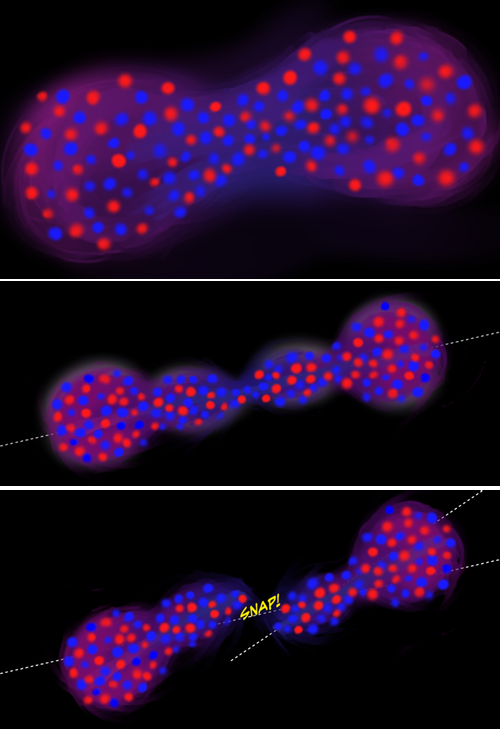Proton-Neutron Equilibration Takes Just 0.3 Zeptoseconds
To understand the process that produces heavy elements in a supernova, theorists need detailed knowledge of the behavior of nuclei under extreme conditions. Now researchers have measured an important aspect of this behavior—the rate at which extreme imbalances in the numbers of neutrons and protons can equilibrate. They found that equilibration can occur in 0.3 zeptoseconds ( seconds). To measure the timing so precisely, the team used an improved detection system to study the composition and direction of motion of the fragments from a collision between zinc nuclei. The results provide new information for theorists developing models for the behavior of nuclear matter in supernovae, neutron stars, and other extreme environments.
Under extreme conditions, neutrons and protons can move quite a bit within the nucleus, and the rate that they move is an important input into the basic theory of nuclear matter called the equation of state. When neutrons and protons are forced to segregate briefly, they rapidly diffuse in order to equalize their numbers throughout the nucleus, a process called neutron-proton (n-p) equilibration. This equilibration is known to happen on the order of a few zeptoseconds ( seconds). Now an experiment by Alan McIntosh of Texas A&M University in College Station and his colleagues has determined just how extraordinarily rapid the equilibration is.
They used the K500 cyclotron at Texas A&M to accelerate zinc-70 nuclei to energies of about 2.5 GeV and fire them at a thin zinc-70 foil. A collision between these nuclei looks a bit like a high-speed liquid drop smashing into a stationary one. The pair merges only briefly before two highly elongated fragments emerge, and each one quickly separates into two smaller blobs. The blobs are unequal in size, with a heavy fragment having 12 to 19 protons and a light fragment with 3 to 11 protons. The researchers detected these two pieces as one of the initially elongated fragments broke apart.
Before the final separation, the elongated fragment is in an asymmetric dumbbell shape with a higher concentration of neutrons at the narrow end. The narrow and fat ends then rapidly exchange neutrons and protons to bring their proportions closer to balance before the breakup.
By measuring the number and composition of heavy and light fragments ejected at different angles to the initial line of collision, McIntosh and his colleagues could deduce the rate of n-p equilibration, using a technique recently introduced by others [1, 2]. The idea is that the dumbbell starts out aligned with the beam direction, and it rotates at constant speed, eventually breaking apart and sending its two fragments out along the final direction of its axis. So the angle of emission is a direct measure of the time since the dumbbell’s creation, and measuring the composition of the final fragments allowed the team to follow the progress of n-p equilibration.
The researchers found that the average equilibration time was just 0.3 zeptoseconds. Previous measurements had determined the timescale more loosely, showing that equilibration was mostly over within 1 zeptosecond [1, 2]. The improved time resolution was made possible in part by an array of detectors that covered a wider area, says McIntosh. And the system was also able to detect and determine the composition of both of the final fragments. In effect, these upgrades gave the researchers a “movie camera” with a frame-rate above frames per second.
The results also show that the exchange process is “first order,” meaning that lone neutrons and protons migrate across the dumbbell and that interactions with other particles on the way are not essential to the process. This migration happens in both directions but is more energetically favorable, and so more likely, if it helps to balance the numbers of neutrons and protons. The data’s high time resolution allowed the team to deduce the first-order nature of the process from the fact that the n-p equilibration curve vs time is a simple decaying exponential function, rather than something more complicated.
The equilibration time measurement will help theorists refine models of nuclear collisions, says McIntosh. “This in turn will help us better describe the nucleosynthesis that occurs in supernovae.”
“This result provides an important benchmark for microscopic models of particle transport in nuclei,” says Romualdo deSouza of Indiana University in Bloomington, who has studied n-p equilibration. The wide angular resolution and good statistics of the new measurements allowed the work to improve on earlier studies, he says.
This research is published in Physical Review Letters.
–Philip Ball
Philip Ball is a freelance science writer in London. His latest book is How Life Works (Picador, 2024).
References
- K. Brown, S. Hudan, R. T. deSouza, J. Gauthier, R. Roy, D. V. Shetty, G. A. Souliotis, and S. J. Yennello, “Timescale for Equilibration of N/Z Gradients in Dinuclear Systems,” Phys. Rev. C 87, 061601 (2013).
- S. Hudan and R. T. deSouza, “Timescale for Isospin Equilibration in Projectile Breakup,” Eur. Phys. J. A 50, 36 (2014).





